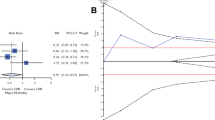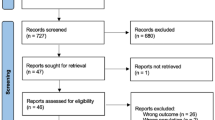Abstract
Background
This study aimed to prospectively quantify the frequency of serious bleeding during pelvic surgery for locally advanced or recurrent rectal cancer and review the surgical methods used to control this.
Methods
Consecutive cases of pelvic surgery for curative resection of locally advanced or recurrent rectal cancer were prospectively evaluated over a nine-month period. The procedures undertaken included multivisceral resections, sacrectomies or ultra-low anterior resections. Multivisceral resections were defined as pelvic exenterations, extra-levator abdominoperineal resections (ELAPER) and recurrent anterior resections. The primary endpoint was the proportion of patients sustaining major blood loss, defined as ≥1,000 ml. The secondary endpoint was the blood transfusion rate. Haemostatic adjunct use was recorded.
Results
Twenty-six patients underwent surgery, comprising 11 pelvic exenterations, 3 ELAPERs, 1 recurrent anterior resection, 5 abdominosacral resections and 6 ultra-low anterior resections. The median intraoperative blood loss was 1,250 ml with 53.8 % of the patients sustaining a loss ≥1,000 ml. Fifty per cent of patients required a blood transfusion within 24 h, and one or more haemostatic adjuncts were necessary in 50 % of the cases. Adjuncts used included a fibrinogen/thrombin haemostatic agent in 38.5 % of patients, temporary intraoperative pelvic packing in 11.5 % of patients and preoperative internal iliac artery embolization in 7.7 % of patients.
Conclusions
This patient group is at a high risk of intraoperative haemorrhage, and such patients are high consumers of blood products. Haemostatic adjunct use is often necessary to minimize blood loss. We describe our local algorithm to assist in the assessment and intraoperative management of these challenging cases.




Similar content being viewed by others
References
Stolfi VM, Milsom JW, Lavery IC, Oakley JR, Church JM, Fazio VW (1992) Newly designed occluder pin for presacral haemorrhage. Dis Colon Rectum 35:166–169
D’Ambra L, Berti S, Bonfante P, Bianchi C, Gianquinto D, Falco E (2009) Hemostatic step-by-step procedure to control presacral bleeding during laparoscopic total mesorectal excision. World J Surg 33:812–815
Baqué P, Karimdjee B, Iannelli A et al (2004) Anatomy of the presacral venous plexus: implications for rectal surgery. Surg Radiol Anat 26:355–358
Germanos S, Bolanis I, Saedon M, Baratsis S (2010) Control of presacral venous bleeding during rectal surgery. Am J Surg 200:e33–e35
Hill AD, Menzies-Gow N, Darzi A (1994) Methods of controlling presacral bleeding. J Am Coll Surg 178:183–184
Wang QY, Shi WJ, Zhao YR, Zhou WQ, He ZR (1985) New concepts in severe presacral hemorrhage during proctectomy. Arch Surg 120:1013–1020
Zama N, Fazio VW, Jagelman DG, Lavery IC, Weakley FL, Church JM (1988) Efficacy of pelvic packing in maintaining hemostasis after rectal excision for cancer. Dis Colon Rectum 31:923–928
Wydra D, Emerich J, Ciach K, Dudziak M, Marciniak A (2004) Surgical pelvic packing as a means of controlling massive intraoperative bleeding during pelvic posterior exenteration—a case report and review of the literature. Int J Gynecol Cancer 14:1050–1054
Cosman BC, Lackides GA, Fisher DP, Eskenazi LB (1994) Use of tissue expander for tamponade of presacral hemorrhage. Report of a case. Dis Colon Rectum 37:723–726
Shanmugam V, Robinson MH (2009) Case report of uncontrollable pelvic bleeding managed by a previously unreported method (QuikClot®). Colorectal Dis 11:221–222
Zhang CH, Song XM, He YL et al (2012) Use of absorbable hemostatic gauze with medical adhesive is effective for achieving hemostasis in presacral hemorrhage. Am J Surg 203:e5–e8
Bhangu A, Brown G, Akmal M, Tekkis P (2012) Outcome of abdominosacral resection for locally advanced primary and recurrent rectal cancer. Br J Surg 99:1453–1461
Ferenschild FT, Vermaas M, Verhoef C, Dwarkasing RS, Eggermont AM, de Wilt JH (2009) Abdominosacral resection for locally advanced and recurrent rectal cancer. Br J Surg 96:1341–1347
Wanebo HJ, Begossi G, Varker KA (2005) Surgical management of pelvic malignancy: role of extended abdominoperineal resection/exenteration/abdominal sacral resection. Surg Oncol Clin N Am 14:197–224
Moriya Y, Akasu T, Fujita S, Yamamoto S (2005) Total pelvic exenteration with distal sacrectomy for fixed recurrent rectal cancer. Surg Oncol Clin N Am 14:225–238
Harlaar JJ, Gosselink MP, Hop WC, Lange JF, Busch OR, Jeekel H (2012) Blood transfusions and prognosis in colorectal cancer: long-term results of a randomized controlled trial. Ann Surg 256:681–686 (discussion 686–687)
Melton GB, Paty PB, Boland PJ et al (2006) Sacral resection for recurrent rectal cancer: analysis of morbidity and treatment results. Dis Colon Rectum 49:1099–1107
Bansal N, Roberts WS, Apte SM, Lancaster JM, Wenham RM (2009) Electrothermal bipolar coagulation decreases the rate of red blood cell transfusions for pelvic exenterations. J Surg Oncol 100:511–514
Parker MC, Pohlen U, Borel Rinkes IH, Delvin T (2013) The application of TachoSil® for sealing colorectal anastomosis: a feasibility study. Colorectal Dis 15:252–725
Civelek A, Yeğen C, Aktan AO (2002) The use of bonewax to control massive presacral bleeding. Surg Today 32:944–945
Timmons MC, Kohler MF, Addison WA (1991) Thumbtack use for control of presacral bleeding, with description of an instrument for thumbtack application. Obstet Gynecol 78:313–315
Beyond TME Collaborative (2013) Consensus statement on the multidisciplinary management of patients with recurrent and primary rectal cancer beyond total mesorectal excision planes. Br J Surg 100:E1–E33
Acheson AG, Brookes MJ, Spahn DR (2012) Effects of allogeneic red blood cell transfusions on clinical outcomes in patients undergoing colorectal cancer surgery: a systematic review and meta-analysis. Ann Surg 256:235–244
Amato A, Pescatori M (2006) Perioperative blood transfusions for the recurrence of colorectal cancer. Cochrane Database Syst Rev 25:CD005033
Lucarotti ME, Armstrong CP, Bartolo DC (1991) Control of presacral bleeding in rectal surgery. Ann R Coll Surg Engl 73:289–290
Stewart BT, McLaughlin SJ (1996) Control of pre-sacral haemorrhage by drawing pin tamponade. Aust N Z J Surg 66:715–716
Wang LT, Feng CC, Wu CC, Hsiao CW, Weng PW, Jao SW (2009) The use of table fixation staples to control massive presacral hemorrhage: a successful alternative treatment. Report of a case. Dis Colon Rectum 52:159–161
Joseph P, Perakath B (2011) Control of presacral venous bleeding with helical tacks on PTFE pledgets combined with pelvic packing. Tech Coloproctol 15:79–80
Ng X, Chiou W, Chang S (2008) Controlling a presacral hemorrhage by using a saline bag: report of a case. Dis Colon Rectum 51:972–974
Harrison JL, Hooks VH, Pearl RK et al (2003) Muscle fragment welding for control of massive presacral bleeding during rectal mobilization: a review of eight cases. Dis Colon Rectum 46:1115–1117
Remzi FH, Oncel M, Fazio VW (2002) Muscle tamponade to control presacral venous bleeding: report of two cases. Dis Colon Rectum 45:1109–1111
Ayuste E Jr, Roxas MF (2004) Validating the use of rectus muscle fragment welding to control presacral bleeding during rectal mobilization. Asian J Surg 27:18–21
Conflict of interest
None of the authors have any relevant conflicts of interest to disclose.
Author information
Authors and Affiliations
Corresponding author
Rights and permissions
About this article
Cite this article
Bonello, V.A., Bhangu, A., Fitzgerald, J.E.F. et al. Intraoperative bleeding and haemostasis during pelvic surgery for locally advanced or recurrent rectal cancer: a prospective evaluation. Tech Coloproctol 18, 887–893 (2014). https://doi.org/10.1007/s10151-014-1150-z
Received:
Accepted:
Published:
Issue Date:
DOI: https://doi.org/10.1007/s10151-014-1150-z




